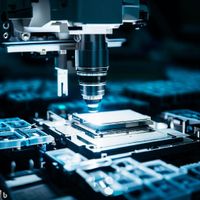It is our goal to constantly bring technological solutions that meet, improve or event exceed the expectation of our customers requirements.
Optics product development involves the design, manufacturing, and improvement of products related to the field of optics, which includes devices and systems that manipulate and control light. Optics products can range from simple optical components like lenses and mirrors to complex systems such as cameras, microscopes, lasers, and optical sensors. Our Product Development team can meet your technology needs, developing designs and processes that work best for you from idea to manufacturing. Development process is based not only on industry standards but also on our customers’ needs and future growth plans. Here are key aspects of optics product development we follow:
1. Conceptualization and Requirements:
The development process begins with identifying the specific needs and requirements of the product. This involves understanding the target application, performance specifications, environmental conditions, cost considerations, and desired functionality.
2. Design and Prototyping:
Optical engineers work on designing the optical elements, such as lenses, filters, prisms, and diffraction gratings, and integrating them into the overall system. Computer-aided design (CAD) tools and simulation software are often used to optimize the performance and evaluate the feasibility of the design. Prototyping allows for testing and validation of the design before proceeding to mass production.
3. Materials Selection:
Selecting the appropriate materials is crucial for optical products. Factors such as refractive index, transmission properties, mechanical stability, and durability need to be considered when choosing materials for lenses, coatings, substrates, and other optical components.
4. Manufacturing and Assembly:
Optics products are manufactured using various techniques, such as precision machining, molding, thin-film deposition coating, polishing, and assembly. Tight tolerances and quality control processes are necessary to ensure the optical elements meet the required specifications.
5. Testing and Characterization:
Optical products undergo rigorous testing and characterization to validate their performance and ensure they meet the desired specifications. This will include measurements of optical properties like transmission, reflection, dispersion, and imaging quality using specialized equipment and techniques.
6. Iterative Improvement:
Feedback from testing and customer feedback is used to identify areas for improvement in optical products. This iterative process involves making design modifications, optimizing manufacturing processes, and implementing enhancements to achieve better performance, reliability, and cost-effectiveness.
7. Compliance and Certification:
Depending on the application and market, optics products have to comply with specific industry standards and certifications. This will include safety regulations, optical performance standards, electromagnetic compatibility (EMC) requirements, and environmental regulations.
8. Documentation and Intellectual Property Protection:
Comprehensive documentation, including design specifications, manufacturing processes, testing procedures, and quality control records, is important for traceability and future reference. Protecting intellectual property through patents or trade secrets is also crucial to safeguard innovations.
Optics product development requires interdisciplinary collaboration, involving optical engineers, mechanical engineers, electrical engineers, materials scientists, and other specialists. It demands a thorough understanding of optics principles, manufacturing techniques, and quality control processes to deliver high-quality optical products that meet customer requirements.







